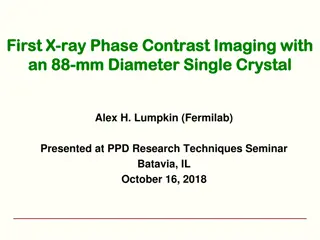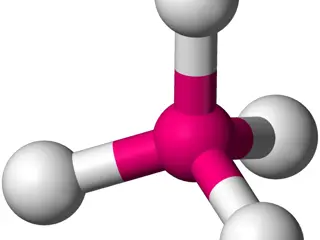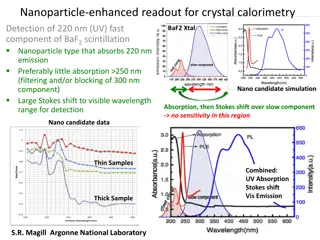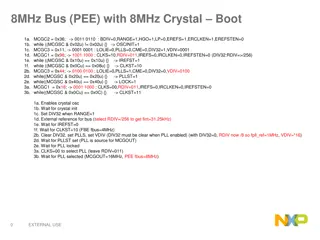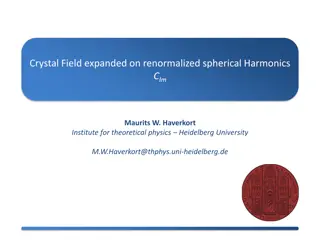Understanding Crystal Field Theory in Chemistry
Crystal Field Theory (CFT) explains how electron orbital degeneracies, particularly d or f orbitals, are affected by a static electric field generated by neighboring anions. In CFT, the metal ion is considered positive while ligands are negative charges, leading to attractive and repulsive forces affecting the energy levels of d orbitals. The approach of ligands destabilizes d orbitals, increasing their energy. This theory helps in understanding the splitting of d orbitals into different energy levels in the presence of a ligand field in molecules like octahedral complexes. Crystal field splitting energy influences electron occupancy in different orbital sets, leading to distinctions between low-spin and high-spin complexes based on the presence of unpaired electrons.
Download Presentation

Please find below an Image/Link to download the presentation.
The content on the website is provided AS IS for your information and personal use only. It may not be sold, licensed, or shared on other websites without obtaining consent from the author. Download presentation by click this link. If you encounter any issues during the download, it is possible that the publisher has removed the file from their server.
E N D
Presentation Transcript
Crystal Field Theory.. Crystal field theory (CFT) describes the breaking of degeneracies of electron orbital states, usually d or f orbitals, due to a static electric field produced by a surrounding charge distribution (anion neighbors)
Crystal field theory (CFT) considers metal as positive ion and ligand as negative point charges. Electrostatic force of attraction develop between the central positive ion and the surrounding negative ligand field. Apart from force of attraction, repulsive forces also develop between d electrons of metal and the surrounding negative field.
So as the ligandsnds approach Central atom the repulsion between negative ligands and electomselectrons of d orbitals increases. This increase in repulsion distabilises the d orbital electrons and it s energy is increased.
If we put three axises in this molecule in the direction of ligands,then effect of repulsion is more clear.
Orientation of different d-orbitals in an Octahedral field of six ligands.
Dxy,dyz,and dzx orbitals are having lobes in between the axis. dx2-y2 Orbital is Pointing lobes exactly in the direction of x and y axis And dz2 is Pointing lobes in z directions.
This splitting of d orbitals in two groups in presence of ligand field is called Crystal field splitting(CFT).
In an octahedral complex, the d orbitals of the central metal ion divide into two sets of different energies.The separation in energy is the crystal field splitting energy, . (A) When is large, it is energetically more favourable for electrons to occupy the lower set of orbitals. >P(strong field): Low spin complex <P(Weak field) : High spin Definition of Both Low spin complexes is that high spin complexes contain unpaired electrons, whereas low spin complexes tend to contain paired electrons. These are called spin states of complexes. We can determine these states using crystal field theory and ligand field theory.
Crystal Field Splitting In Tetrahedral Field. The tetrahedral crystal field splits these orbitals into the same t2g and eg sets of orbitals as does the octahedral crystal field. The dx2-y2 and dz2 orbitals on the metal ion at the center of the cube lie between the ligands, and the dxy, dxz, and dyz orbitals point toward the ligands.
Crystal Field Splitting In Tetragonal And Square Planar Complexes If two trans- ligands in and octahedral complex are either chemically different from the other four (as in trans-[Co(NH3)4Cl2]+), or at a different distance from the metal than the other four, the result is a tetragonally distorted octahedral complex. There is a large energy separation between the dz orbital and the dxz and dyz orbitals, meaning that the crystal field splitting energy is large. We find that the square planar complexes have the greatest crystal field splitting energy compared to all the other complexes.
CBipyramidad Splitting In Trigonal Bipyramidal complexes In trigonal bipyramidal geometry, the three ligands lie along the corners of an triangle at an angle of 120 each forming the puramid bases in XY plane. The two ligandse perpendicular to the base triangle along Z-axis.









